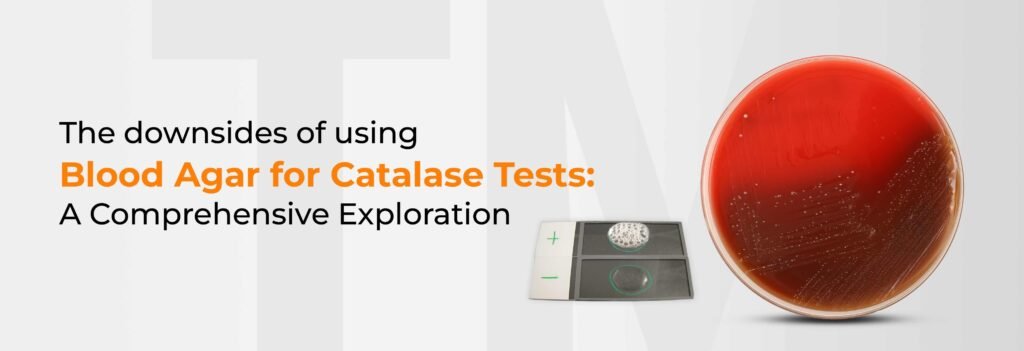

In the microbiological world, the choice of Culture Media plays a pivotal role in the accurate identification of microorganisms. One such commonly used medium is Blood Agar, prized for its ability to support the growth of a wide range of fastidious microorganisms.
However, when it comes to catalase tests, caution should be exercised before employing Blood Agar as the substrate. In this blog, we will explore the reasons why Blood Agar might not be the ideal choice for catalase tests, shedding light on potential difficulties and alternatives for a more accurate and reliable analysis.
Understanding Catalase Tests
Catalase is an enzyme produced by many bacteria that catalyses the decomposition of hydrogen peroxide into water and oxygen. This reaction produces visible bubbles of oxygen gas, a characteristic feature of catalase-positive organisms. The catalase test is a valuable tool in microbiology for differentiating between catalase-positive and catalase-negative bacteria.
Consequences of Using Blood Agar for Catalase Tests
Blood Agar is commonly used for the isolation and identification of various microorganisms, including those that are catalase positive. When performing a catalase test on Blood Agar, the inherent catalase activity of the medium can lead to false-positive results. This occurs when the bubbles observed during the test are a result of the catalase present in the blood agar rather than the microorganism being tested.
Blood Agar is known for its ability to showcase different haemolysis patterns, such as alpha, beta, and gamma haemolysis. These patterns can often interfere with the interpretation of catalase test results. The presence of blood components in the agar may mask or alter the appearance of bubbles formed during the catalase reaction, making it challenging to accurately assess the catalase activity of the tested microorganism.
Catalase tests are typically qualitative, relying on the visual observation of bubbles formed during the reaction. The complex composition can introduce ambiguity in result interpretation. Distinguishing between the catalase activity of the microorganism and potential interference from the medium becomes challenging, leading to unreliable outcomes.
Blood Agar formulations can vary among manufacturers and laboratories. Differences in the concentration of blood components, nutrients, and other additives may impact the catalase activity of the medium. This variability can further contribute to inconsistencies in catalase test results, making it difficult to establish a standardized and reliable protocol.
Alternatives to Blood Agar for Catalase Tests
To overcome the limitations associated with using Blood Agar for catalase tests, microbiologists can consider alternative Culture Media that are specifically designed for catalase testing.
| Medium | Description | Considerations |
| Nutrient Agar | General-purpose medium with essential nutrients for diverse microorganism growth. | Potential inherent catalase activity in the medium. |
| Tryptic Soy Agar (TSA) | Versatile medium suitable for various microorganisms. | Careful interpretation is needed due to the possible catalase activity in the medium. |
| Brain Heart Infusion (BHI) Agar | Enriched medium designed for fastidious microorganisms. | Check for potential interference from medium components during catalase testing. |
| Sabouraud Dextrose Agar (SDA) | Specifically for fungal cultivation. | Use in cases where fungi are cultured, and catalase testing on bacteria is also required. |
| Mannitol Salt Agar (MSA) | Selective for Staphylococcus species. | Ideal for catalase testing of Staphylococcus, but limited to a broad range of microorganisms. |
| MacConkey Agar | Selective for Gram-negative bacteria, especially Enterobacteriaceae. | May not be the primary choice for catalase tests; suitable for specific applications with Gram-negative organisms. |
These alternatives provide flexibility based on the specific needs of the laboratory and the types of microorganisms under investigation. Careful consideration of the medium’s characteristics, potential interference, and the desired scope of testing is crucial for accurate and reliable catalase test results.
Top of Form
While Blood Agar serves as a versatile medium for various microbiological purposes, its use for catalase tests presents challenges that may compromise the reliability of results. Understanding the limitations and potential pitfalls associated with Blood Agar in catalase testing is crucial for microbiologists seeking accurate identification and characterization of microorganisms. By opting for media like Nutrient Agar, laboratories can enhance the precision of catalase tests, ensuring more dependable outcomes in microbial diagnostics.
With a commitment to excellence, we at TM Media ensure the reliability and consistency of our formulations, catering to the diverse needs of laboratories and research facilities. From reliable Culture Media to Staining Kits, our products are designed to meet the stringent requirements of microbiologists and researchers.

Being a microbiologist, you are definitely aware of the terms MacConkey Agar & E. coli; if not, here in this...
Read More
Hello Microbiologists, remember the first agar that you prepare, the yellowish jelly. Yes, you are thinking right; we are talking...
Read More
The specter of antimicrobial resistance (AMR) hangs over modern medicine. Antibiotics – once a miracle are losing their power as...
Read More
We are thrilled to announce that TM Media has been recognized as the LeadingBiotechnology Company at the prestigious 6th Elets...
Read More
Think of a field as a big garden where tiny superheroes, called microbes, work behind the scenes. They’re not just...
Read More
Maintaining the highest standards of quality and safety is paramount in pharmaceutical manufacturing. Strict adherence to current good manufacturing practices...
Read More